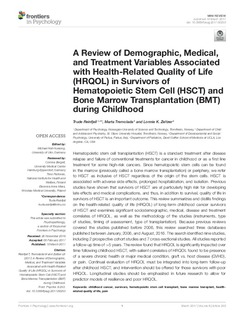| dc.description.abstract | Hematopoietic stem cell transplantation (HSCT) is a standard treatment after disease relapse and failure of conventional treatments for cancer in childhood or as a first line treatment for some high-risk cancers. Since hematopoietic stem cells can be found in the marrow (previously called a bone marrow transplantation) or periphery, we refer to HSCT as inclusive of HSCT regardless of the origin of the stem cells. HSCT is associated with adverse side effects, prolonged hospitalization, and isolation. Previous studies have shown that survivors of HSCT are at particularly high risk for developing late effects and medical complications, and thus, in addition to survival, quality of life in survivors of HSCT is an important outcome. This review summarizes and distills findings on the health-related quality of life (HRQOL) of long-term childhood cancer survivors of HSCT and examines significant sociodemographic, medical, disease and treatment correlates of HRQOL, as well as the methodology of the studies (instruments, type of studies, timing of assessment, type of transplantation). Because previous reviews covered the studies published before 2006, this review searched three databases published between January, 2006, and August, 2016. The search identified nine studies, including 2 prospective cohort studies and 7 cross-sectional studies. All studies reported a follow-up time of >5 years. The review found that HRQOL is significantly impacted over time following childhood HSCT, with salient correlates of HRQOL found to be presence of a severe chronic health or major medical condition, graft vs. host disease (GVHD), or pain. Continual evaluation of HRQOL must be integrated into long-term follow-up after childhood HSCT, and intervention should be offered for those survivors with poor HRQOL. Longitudinal studies should be emphasized in future research to allow for predictor models of resilience and poor HRQOL. | nb_NO |
| dc.description.localcode | © 2017 Reinfjell, Tremolada and Zeltzer. This is an open-access article distributed under the terms of the Creative Commons Attribution License (CC BY). The use, distribution or reproduction in other forums is permitted, provided the original author(s) or licensor are credited and that the original publication in this journal is cited, in accordance with accepted academic practice. No use, distribution or reproduction is permitted which does not comply with these terms. | nb_NO |

